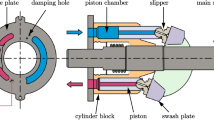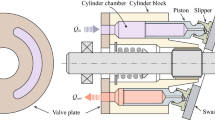Abstract
The power density of axial piston pumps can benefit greatly from increased rotational speeds. However, the maximum rotational speed of axial piston machines is limited by the cavitation phenomenon for a given volumetric displacement. This paper presents a scaling law derived from an analytical cavitation model to estimate the speed limitations for the same series of axial piston pumps. The cavitation model is experimentally verified using a high-speed axial piston pump, and the scaling law is validated with open specification data in product brochures. Results show that the speed limitation is approximately proportional to the square root of the inlet pressure and inversely proportional to the cube root of volumetric displacement. Furthermore, a characteristic constant Cp is defined based on the presented scaling law. This constant can represent the comprehensive capacity of axial piston pumps free from cavitation.
Similar content being viewed by others
References
Tanaka Y, Sakama S, Nakano K, et al. Comparative study on dynamic characteristics of hydraulic, pneumatic and electric motors. In: Proceedings of ASME/BATH 2013 Symposium on Fluid Power and Motion Control. Sarasota: ASME, 2013, V001T01A037
Manring N D, Mehta V S, Nelson B E, et al. Increasing the power density for axial-piston swash-plate type hydrostatic machines. Journal of Mechanical Design, 2013, 135(7): 071002
Kunkis M, Weber J. Experimental and numerical assessment of an axial piston pump’s speed limit. In: Proceedings of BATH/ASME 2016 Symposium on Fluid Power and Motion Control. Bath: ASME, 2016, V001T01A048
Wu S, Yu B, Jiao Z, et al. Preliminary design and multi-objective optimization of electro-hydrostatic actuator. Proceedings of the Institution of Mechanical Engineers, Part G: Journal of Aerospace Engineering, 2017, 231(7): 1258–1268
Alle N, Hiremath S S, Makaram S, et al. Review on electro hydrostatic actuator for flight control. International Journal of Fluid Power, 2016, 17(2): 125–145
Chao Q, Zhang J, Xu B, et al. A review of high-speed electrohydrostatic actuator pumps in aerospace applications: Challenges and solutions. Journal of Mechanical Design, 2019, 141(5): 050801
Harris R M, Edge K A, Tilley D G. Predicting the behavior of slipper pads in swashplate-type axial piston pumps. Journal of Dynamic Systems, Measurement, and Control, 1996, 118(1): 41–47
Manring N D. Slipper tipping within an axial-piston swash-plate type hydrostatic pump. In: Proceedings of ASME International Mechanical Engineering Congress and Exposition. Anaheim: ASME, 1998, 169–175
Borghi M, Specchia E, Zardin B, et al. The critical speed of slipper bearings in axial piston swash plate type pumps and motors. In: Proceedings of ASME 2009 Dynamic Systems and Control Conference. Hollywood: ASME, 2009, 267–274
Manring N D. Tipping the cylinder block of an axial-piston swashplate type hydrostatic machine. Journal of Dynamic Systems, Measurement, and Control, 2000, 122(1): 216–221
Achten P, Eggenkamp S. Barrel tipping in axial piston pumps and motors. In: Proceedings of the 15th Scandinavian International Conference on Fluid Power. Linköping, 2017, 381–391
Zhang J, Chao Q, Xu B. Analysis of the cylinder block tilting inertia moment and its effect on the performance of high-speed electrohydrostatic actuator pumps of aircraft. Chinese Journal of Aeronautics, 2018, 31(1): 169–177
Halat J A. Hydraulic Pumps for High Pressure Non-Flammable Fluids. SAE Technical Paper 2000-01-2581, 1985
Chao Q, Zhang J, Xu B, et al. Centrifugal effects on cavitation in the cylinder chambers for high-speed axial piston pumps. Meccanica, 2019, 54(6): 815–829
Chao Q, Zhang J, Xu B, et al. Effects of inclined cylinder ports on gaseous cavitation of high-speed electro-hydrostatic actuator pumps: A numerical study. Engineering Applications of Computational Fluid Mechanics, 2019, 13(1): 245–253
Wang Y, Dong H, He Y. A novel approach for predicting inlet pressure of aircraft hydraulic pumps under transient conditions. Chinese Journal of Aeronautics, 2019, 32(11): 2566–2576
Dong H, Wang Y, Chen J. First attempt to determine the critical inlet pressure for aircraft pumps with a numerical approach that considers vapor cavitation and air aeration. Proceedings of the Institution of Mechanical Engineers, Part G: Journal of Aerospace Engineering, 2020, 234(12): 1926–1938
Vacca A, Klop R, Ivantysynova M. A numerical approach for the evaluation of the effects of air release and vapour cavitation on effective flow rate of axial piston machines. International Journal of Fluid Power, 2010, 11(1): 33–45
Gullapalli S, Michael P, Kensler J, et al. An investigation of hydraulic fluid composition and aeration in an axial piston pump. In: Proceedings of ASME/BATH 2017 Symposium on Fluid Power and Motion Control. Sarasota: ASME, 2017, V001T01A028
Chao Q, Tao J, Wei X, et al. Identification of cavitation intensity for high-speed aviation hydraulic pumps using 2D convolutional neural networks with an input of RGB-based vibration data. Measurement Science and Technology, 2020, 31(10): 105102
Fey C G, Totten G E, Bishop R J, et al. Analysis of Common Failure Modes of Axial Piston Pumps. SAE Technical Paper 2000-01-2581, 2000
Frosina E, Marinaro G, Senatore A. Experimental and numerical analysis of an axial piston pump: A comparison between lumped parameter and 3D CFD approaches. In: Proceedings of ASME-JSME-KSME 2019 the 8th Joint Fluids Engineering Conference. San Francisco: ASME, 2019, V001T01A042
Schleihs C, Viennet E, Deeken M, et al. 3D-CFD simulation of an axial piston displacement unit. In: Proceedings of the 9th International Fluid Power Conference. Aachen, 2014, 332–343
Li T. Study on bootstrap reservoir type pressurized system for civil aircraft hydraulic supply system. In: Proceedings of 2016 IEEE International Conference on Aircraft Utility Systems (AUS). Beijing: IEEE, 2016, 1117–1121
Eaton. Engine-driven pump model PV3-240-18. Available at Eaton website, 2020-7-30
Mohn G, Nafz T. Swash plate pumps—The key to the future. In: Proceedings of the 10th International Fluid Power Conference. Dresden: Dresden University of Technology, 2016, 139–150
Bügener N, Helduser S. Analysis of the suction performance of axial piston pumps by means of computational fluid dynamics (CFD). In: Proceedings of the 7th International Fluid Power Conference. Aachen, 2010
Bügener N, Klecker J, Weber J. Analysis and improvement of the suction performance of axial piston pumps in swash plate design. International Journal of Fluid Power, 2014, 15(3): 153–167
Kosodo H. Development of micro pump and micro-HST for hydraulics. JFPS International Journal of Fluid Power System, 2012, 5(1): 6–10
Wang S. The analysis of cavitation problems in the axial piston pump. Journal of Fluids Engineering, 2010, 132(7): 074502
Shi Y, Lin T, Meng G, et al. A study on the suppression of cavitation flow inside an axial piston pump. In: Proceedings of 2016 Prognostics and System Health Management Conference. Chengdu: IEEE, 2016
Manring N D, Mehta V S, Nelson B E, et al. Scaling the speed limitations for axial-piston swash-plate type hydrostatic machines. Journal of Dynamic Systems, Measurement, and Control, 2014, 136(3): 031004
Svedberg G C, Totten G E, Sun Y H, et al. Hydraulic system cavitation: Part II—A review of hardware design-related effects. SAE Transactions, 1999, 108: 385–397
Bishop R J, Totten G E. Effect of pump inlet conditions on hydraulic pump cavitation: A review. In: Totten G, Wills D, Feldmann D, eds. Hydraulic Failure Analysis, Fluids, Components and System Effects. West Conshohocken: ASTM International, 2001, 318–332
Hibi A, Ibuki T, Ichikawa T, et al. Suction performance of axial piston pump: 1st report, analysis and fundamental experiments. Bulletin of the JSME, 1977, 20(139): 79–84
Acknowledgements
This work was supported by the China National Postdoctoral Program for Innovative Talents (Grant No. BX20200210), the China Postdoctoral Science Foundation (Grant No. 2019M660086), and the Common Technology for Equipment Pre-research Project (Grant No. 41402050202).
Author information
Authors and Affiliations
Corresponding author
Rights and permissions
About this article
Cite this article
Chao, Q., Tao, J., Lei, J. et al. Fast scaling approach based on cavitation conditions to estimate the speed limitation for axial piston pump design. Front. Mech. Eng. 16, 176–185 (2021). https://doi.org/10.1007/s11465-020-0616-0
Received:
Accepted:
Published:
Issue Date:
DOI: https://doi.org/10.1007/s11465-020-0616-0




